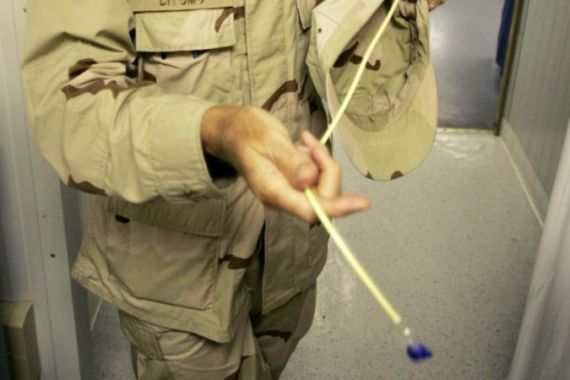Gitmo officials alter hunger strike protocols
In move shrouded in secrecy, officials admit they have revised procedures regarding controversial prisoner protest.

Officials at Guantanamo Bay have implemented revised protocols for hunger strikes and force-feeding, according to a Justice Department letter obtained by Al Jazeera. The controversial military detention center keeps scores of detainees imprisoned, often without charge.
The move comes as officials at the base disclosed this week that they would no longer release new figures to journalists on a hunger strike that is currently underway. As of Monday, the last day Guantanamo officials released fresh numbers, 15 prisoners were protesting, up by two from the previous week. All of the hunger strikers were reportedly being force-fed.
According to the Justice Department letter, officials at the base revised their protocols for dealing with the hunger strike and force-feeding methods on Nov. 14 to “better focus on the adverse health effects of clinically significant weight loss on each individual detainee.”
But mystery surrounds exactly what those changes are. Navy Cmdr. John Filostrat, the prison spokesman, declined to disclose details about what exactly changed in the Standard Operating Procedure (SOP), or to answer any questions about why the changes were made. Filostrat said to do so would interfere with “operational security.”
The hunger strike, which began earlier this year and involved more than 100 prisoners at its peak, created headlines worldwide and helped pressure President Barack Obama into repeating a previously stated aim of shutting down the base. But critics continue to accuse his administration of doing too little to implement that goal.
The revisions to the SOP were disclosed in a letter, dated Nov. 21 and signed by Justice Department attorney Daniel J. Lenerz. The letter was submitted to the U.S. Court of Appeals for the Washington, D.C., circuit as part of a long-running lawsuit filed earlier this year by attorneys representing a group of Guantanamo prisoners who are seeking to halt the force-feeding of hunger strikers.
Officials also decided this week to stop giving out information on the constantly fluctuating number of hunger strike participants out of a belief that the information had been helping the protesters.
“Our policy is to no longer publicly issue the number of detainees who choose not to eat as a matter of protest at Guantanamo,” Filostrat said.
“Guantanamo allows detainees to peacefully protest, but will not further their protests by reporting the numbers to the public,” he said. “The release of this information serves no operational purpose and detracts from the more important issues, which are the welfare of detainees and the safety and security of our troops.”
Previously, authorities had sent out daily updates on the number of detainees involved in the protest, including figures on those who were being force-fed. In September, a decision was made to stop those announcements but still release relevant numbers when journalists specifically asked. Now even that information will not be released.
‘To eat a standard meal’
Critics say the new policy contradicts one of the taglines on Joint Task Force-Guantanamo’s website, which says that its operations are “safe, legal, humane, transparent.”
The refusal to provide details about the revised SOP is another contradiction in transparency at the prison. A Guantanamo official in May did share the prison’s most recent SOP at that time with Al Jazeera, but specifics about the revision are now being withheld.
The most controversial elements of the previous SOP included a requirement that any hunger-striking prisoner wear a surgical mask over his mouth while sitting shackled in a restraint chair for as long as two hours with a 2-foot tube snaked through a nostril until a chest X-ray, or a test dose of water, confirmed food had reached his stomach.
At the end of the feeding, the prisoner was to be removed from the restraint chair and placed into a “dry cell” with no running water. A guard would then observe the prisoner for 45 to 60 minutes “for any indications of vomiting or attempts to induce vomiting.” If the prisoner vomited, he was returned to the restraint chair.
The procedure has been widely condemned as a form of torture and criticized by medical organizations who say the policy forces physicians performing the procedure to violate their medical ethics.
The Justice Department letter gave no details on the exact revisions to its protocols, but it did repeat a statement that all prisoners are offered the chance to eat a normal meal before force-feeding.
“Prior to every feeding, the detainee is offered the opportunity to eat a standard meal or consume a liquid nutritional supplement orally,” the letter said.
Cori Crider, the strategic director of Reprieve, a U.K.-based human rights charity representing Shaker Aamer, the last British prisoner and the lead plaintiff in the force-feeding lawsuit, said the government had shared the new SOP with her. However, she is bound by a protective order and is prohibited from discussing its contents.
Crider said the government has not filed a copy of the SOP with the court but indicated that she could do so under seal.
“It’s bizarre that Guantanamo (officials) are trying to suppress the publication of new protocols, given they gave the original ones to a journalist first,” Crider told Al Jazeera.
Meanwhile, on Thursday the United States announced it had transferred two Guantanamo prisoners back to Algeria. The pair, Djamel Saiid Ali Ameziane and Bensayah Belkecem, had spent more than 10 years at the detention center.